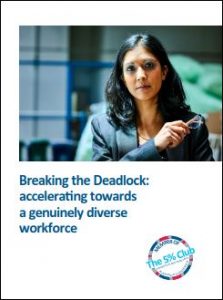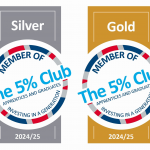Action from business heads, industry sectors and the Government, is urgently required to drive a more diverse and inclusive uptake of earn and learn[1] placements, according to The 5% Club in its report, ‘Breaking the Deadlock‘.
‘Breaking the Deadlock’ involved consultation with members of The 5% Club and provides recommendations for tackling the ‘diversity deadlock’ in the UK’s workforce to ensure a diverse talent pipeline. According to The 5% Club, there are three key drivers for change:
- Business heads must demonstrate an unequivocal lead – improving the collection of diversity data should be a priority in order to set targets and measure progress;
- Sectors must coordinate their approach to maximise impact. At present, a range of activities take place in a piecemeal fashion;
- Government must deploy the right regulation to speed up the pace of change while ensuring a level playing field. Regulation must be achievable however, and must not be overly onerous

In the report, members also detail ‘top tips’ to help companies offering earn and learn opportunities to attract, identify and retain candidates from every background – critical for both a strong society and strong economy. For example, reciprocal mentoring, blind CVs and unconscious bias training.
Despite research which proves that businesses with a diverse workforce consistently outperform those without,[2] hidden barriers to diversity still exist in recruitment processes and early career workforces remain imbalanced. Only 11.3%[3] of apprenticeship starts are made by BAME applicants, and whilst women represent more than half of all apprentices (54%)[4], women represent only 8.1% of those in STEM.[5] Just 10% of apprenticeship starts are by people with learning difficulties and / or disabilities.[6]
Leo Quinn, Chairman and Founder of The 5% Club, and Group Chief Executive of Balfour Beatty expands: “The 5% Club stands strong in our belief that the diversity and inclusion deadlock can indeed be broken – and action must be taken immediately given the skills gaps which exist across our economy. Businesses need to collect better data, think outside the box in how they recruit and ensure workplaces and business cultures are inclusive and welcoming to people from different backgrounds.
“The Government must also play its part, using the levers it has available. It must provide balanced careers advice, educating teachers, young people and parents from all backgrounds, about the range of earn and learn opportunities available, as well as encouraging young people – especially girls – to study STEM subjects. The Government must also use their role as a major procurer of goods and services to encourage greater emphasis on diversity among their own suppliers. If we can pull together in a strategic, co-ordinated way, we can deliver change and offer sustainable careers to a larger and more diversified cross-section of people.”
Shaking up traditional diversity and inclusion approaches
Traditional recruitment and retention strategies are no longer fit for purpose in delivering the skilled, diverse workforce businesses need now and in the future. The 5% Club asked a selection of its members for their ‘top tips’ on how companies can look again at HR approaches for earn and learn:
- Introduce “Blind CVs”. The removal of details such as names, gender, age, education, number of years of experience, university or education provider names, will remove bias.
- Seek out new ways of finding possible candidates and target those which are likely to help increase diversity, including specific social media, websites and career fairs not used before.
- Unconscious bias training will ensure that hiring managers are aware of their own potential biases, are able to look beyond them and make decisions based on the suitability of the candidate for the role and company, rather than on snap judgements informed by stereotypes and ingrained beliefs.
- Reciprocal mentoring, or the pairing of senior executives with either people younger than them, of a different gender or race for example, in order to give them a new perspective and deeper understanding of the challenges faced by these groups.
- Ensuring that the CEO and Board are responsible for the diversity and inclusion strategy, in order to give it a level of status within the business that shows how important it is. Similarly, encouraging senior managers to “own” diversity, speaking about it publicly and rewarding behaviours which reflect the diversity and inclusion ethos.
The 5% Club’s ‘Breaking the Deadlock’ report and recommendations is available to download here: Breaking the Deadlock
[1] Earn and learn placements are skills training opportunities provided by a company for members of their workforce. Earn and learn placements can take the form of a formalised apprenticeship, sponsored student and / or graduate training scheme. People are paid a salary whilst undertaking earn and learn skills training. The aim of earn and learn is to build a much broader way for people to enter the job market or re-skill, moving away from the entrenched university focus and create a world-class vocational system in the UK
[2] http://www.mckinsey.com/business-functions/organization/our-insights/why-diversity-matters
[3] Apprenticeship Statistics: England Jan 2018




